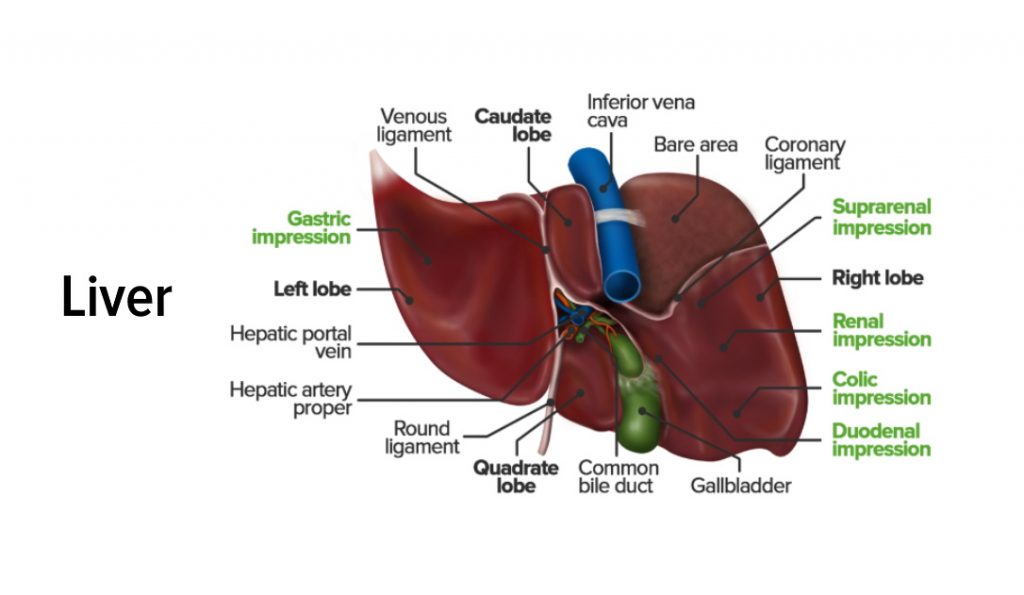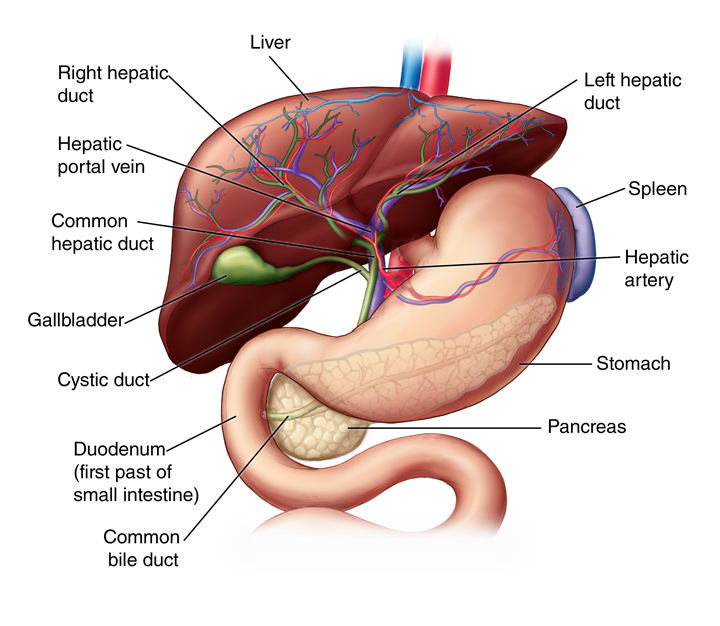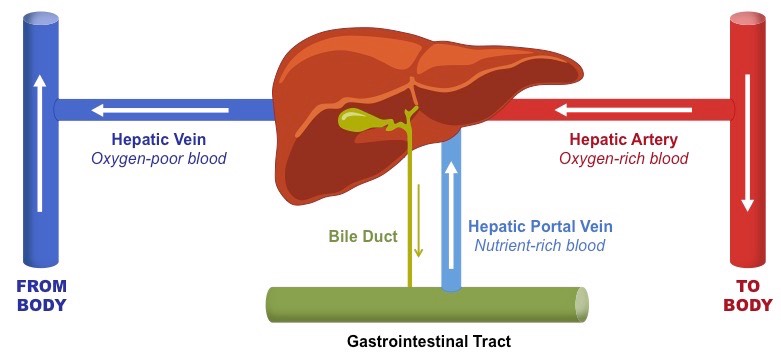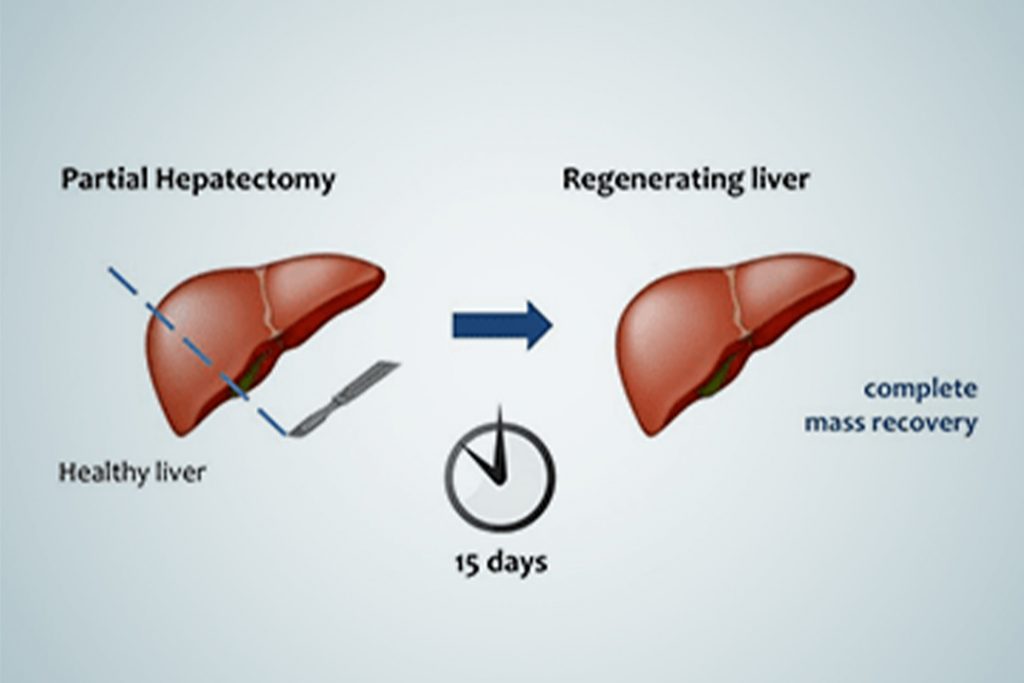The liver, the largest gland in the human body, performs crucial functions that maintain our health. Located in the upper right corner below the diaphragm, it is involved in metabolism, the production of bile and the processing of nutrients. During foetal development, the liver also makes red and white blood cells. The strategic location of this organ allows it to interact with neighbouring organs to facilitate efficient metabolic processes. By metabolising proteins, fats and carbohydrates, the liver provides nutrition for our body
Table of Contents
Structure of the Liver
The liver is a complex organ with a unique anatomical structure. It consists of four lobes– the larger right lobe and the left lobe, as well as the smaller caudate lobe and the quadrate lobe. The right and left lobes are separated by the falciform ligament, which connects the liver to the abdominal wall. Furthermore, the liver can be divided into eight segments, each consisting of thousands of lobules that represent the small functional units of the liver.

The liver is covered by a layer of fibrous connective tissue called the Glisson capsule, which provides it with support and protection. This capsule is also covered by the peritoneum, a membrane that forms the outside of the liver.
Also Check – Structure and functional units of the Liver
Important structural part of the liver’s anatomy-

- Common Hepatic Duct- This tube carries bile out of the liver. It is formed by the intersection of the right and left hepatic ducts.
- Falciform Ligament- A thin, fibrous ligament that separates the two lobes of the liver and connects them to the abdominal wall.
- Glisson’s Capsule- A layer of loose connective tissue that surrounds the liver and its associated arteries and ducts, providing structural support.
- Hepatic Artery- The main blood vessel supplying oxygenated blood to the liver.
- Hepatic Portal Vein- The blood vessel that carries nutrient-rich blood from the gastrointestinal tract, gallbladder, pancreas and spleen to the liver.
- Lobes- The anatomical sections of the liver, including the larger right and left lobes and the smaller caudate and quadrate lobes.
- Lobules- Microscopic building blocks of the liver consisting of hepatocytes arranged in a radial pattern around a central vein.
- Peritoneum- A membrane that covers the liver and forms its external surface, providing protection and support.
In humans, the liver is located in the upper right corner of the body, just below the diaphragm. It is positioned above the small intestine, with the right portion of the stomach above it and the left portion above the stomach.
The structure of the liver in animals is similar to that in humans. It is lined with fibrous connective tissue known as the Glisson capsule. The liver is formed from epithelial tissue and consists of hepatocytes arranged in an anastomosed layer. The hepatocytes secrete various plasma proteins, including lipoproteins and albumin.
The anatomy of the liver includes various lobes, such as the left lateral lobe, left medial lobe, right lateral lobe, right medial lobe, quadrate lobe, caudate lobe and papillary lobe. Each lobe is further divided into eight segments and each segment contains numerous lobules. The lobules have small tubes that join together to form the common hepatic duct, which is responsible for transporting bile from the liver to the gallbladder and duodenum.
The liver receives blood from two sources-
- The oxygenated blood flow from the Hepatic Artery
- The nutrient-rich blood flow from the Hepatic Portal Vein.

Also Check – Arteries in The Body
Functions of the Liver
The liver performs numerous essential functions in the human body. Here is a structured overview of the functions of the liver-
Bile Production and Fat Digestion
- The liver produces bile, which aids in the breakdown and digestion of fats in the small intestine.
- Bile is a watery secretion generated by hepatic cells, transported to the gallbladder for concentration and storage, and delivered into the duodenum.
- Bile acts as a detergent, emulsifying fats and enabling better action of pancreatic enzymes on food particles.
Also Check – Emulsification of Fats
Blood Plasma Protein Production
- The liver synthesises blood plasma proteins, including the prevalent protein albumin.
- Albumin helps maintain the distribution volume of interstitial and intravascular spaces and serves as a plasma component binding protein.
- It provides amino acids, functions as an extravascular scavenger, and undergoes oxidation during inflammation.
Glycogen Storage and Glucose Balance
- The liver performs glycogenesis, converting excess glucose into glycogen for storage.
- Glycogen can be converted back to glucose when needed, ensuring a balanced and constant supply of glucose for energy.
Iron Storage and Haemoglobin Processing
- The liver stores iron from the heme group of blood haemoglobin.
- It processes haemoglobin to utilise its iron content effectively.
Cholesterol and Fat Transport
- The liver produces cholesterol and specific proteins that aid in the transport of fats throughout the body.
Ammonia Detoxification
- The liver converts toxic ammonia, a byproduct of protein metabolism, into urea.
- Urea is excreted through urine, preventing ammonia buildup and its harmful effects.
Blood Filtration and Detoxification
- The liver filters blood from the digestive tract, removing toxins and harmful substances.
- It plays a crucial role in drug metabolism and detoxification processes.
Digestive Function
- The liver produces bile, which aids in the digestion and absorption of fats, vitamins, and cholesterol.
- It stores glucose as glycogen and releases it when the body requires energy.
- The liver clears bilirubin and assists in the breakdown and digestion of proteins.
Vitamin and Mineral Storage
- The liver stores essential vitamins such as A, D, E, K, and B12.
- It also stores iron in the form of ferritin for the production of new red blood cells.
Immunological Function
- The liver contains Kupffer cells, which are involved in immune activity and help eliminate disease-causing agents.
- Albumin Production and Blood Pressure Regulation-
- The liver synthesise albumin, which transports fatty acids and steroids, maintains correct pressure in blood vessels, and prevents leakage.
Angiotensinogen Synthesis
- The liver produces angiotensinogen, a hormone responsible for narrowing blood vessels, leading to an increase in blood pressure.
Also Check – 14 IMPORTANT FUNCTION OF THE LIVER
Common Liver Disorders
The liver is susceptible to various disorders that can impact its structure and function. Here are some common liver disorders-
Hepatitis-
Hepatitis refers to inflammation of the liver, which can be caused by viral infections (hepatitis A, B, C, D, and E), alcohol abuse, autoimmune diseases, or certain medications.
Symptoms include fatigue, jaundice (yellowing of the skin and eyes), abdominal pain, nausea, and loss of appetite.
Hepatitis can lead to chronic liver disease, cirrhosis, or liver cancer if left untreated.
Cirrhosis-
Cirrhosis is a progressive liver disease characterised by the formation of scar tissue, which replaces healthy liver tissue.
Causes include long-term alcohol abuse, chronic viral hepatitis, non-alcoholic fatty liver disease, and certain genetic disorders.
Symptoms may include fatigue, jaundice, abdominal swelling, weight loss, and confusion.
Cirrhosis can result in liver failure and complications such as portal hypertension, ascites (fluid buildup in the abdomen), and hepatic encephalopathy.
Non-Alcoholic Fatty Liver Disease (NAFLD)-
NAFLD is a condition characterised by the accumulation of fat in the liver, not caused by excessive alcohol consumption.
It is commonly associated with obesity, insulin resistance, type 2 diabetes, high cholesterol, and metabolic syndrome.
NAFLD can range from simple fatty liver (steatosis) to non-alcoholic steatohepatitis (NASH), which involves liver inflammation and potential scarring.
If left untreated, NASH can progress to cirrhosis and liver failure.
Alcoholic Liver Disease (ALD)-
ALD is caused by excessive and prolonged alcohol consumption, leading to liver damage.
It encompasses a spectrum of conditions, including fatty liver, alcoholic hepatitis, and cirrhosis.
Symptoms can include jaundice, abdominal pain, swelling, fatigue, and behavioral changes.
Continued alcohol abuse can worsen liver damage and increase the risk of liver cancer.
Liver Cancer-
Liver cancer can originate in the liver (primary liver cancer) or spread from other organs (secondary or metastatic liver cancer).
Risk factors include chronic hepatitis B or C infection, cirrhosis, excessive alcohol consumption, obesity, and certain genetic conditions.
Symptoms may include abdominal pain, unexplained weight loss, jaundice, and swelling.
Early detection and treatment are crucial for improving outcomes.
Autoimmune Hepatitis-
Autoimmune hepatitis is a chronic inflammatory condition in which the immune system mistakenly attacks the liver cells.
The exact cause is unknown, but it is thought to involve genetic and environmental factors.
Symptoms can vary but may include fatigue, jaundice, abdominal discomfort, and joint pain.
Treatment aims to suppress the immune system and reduce inflammation.
Hemochromatosis-
Hemochromatosis is an inherited disorder characterised by excessive iron absorption and accumulation in the liver and other organs.
Symptoms may include fatigue, abdominal pain, joint pain, and liver enlargement.
Treatment involves regular blood removal (phlebotomy) to reduce iron levels and manage complications.
Wilson’s Disease-
Wilson’s disease is a rare genetic disorder that causes copper to accumulate in the liver and other organs.
Symptoms can include fatigue, jaundice, abdominal pain, neurological problems, and psychiatric symptoms.
Treatment involves medications to remove excess copper and dietary modifications.
Regeneration of Liver
The liver possesses a remarkable ability to regenerate itself in various vertebrates, including humans. The process of liver regeneration allows for the restoration of its functions without significant loss. Here are some important facts about the regeneration of the liver–
Regeneration in Humans

In humans, the regeneration of the liver typically takes place within a span of 8 to 15 days.
After surgical removal of a portion of the liver (partial hepatectomy) or in response to injury, the remaining liver cells rapidly multiply to restore the lost tissue.
The liver’s regenerative capacity ensures that its essential functions, such as bile production, detoxification, and metabolism, continue uninterrupted.
Regeneration in Mice
In mice, the process of liver regeneration occurs at a faster rate compared to humans, typically spanning around 5 to 7 days.
Following liver injury or partial hepatectomy, the remaining hepatocytes, which are the primary liver cells, undergo rapid proliferation to compensate for the lost tissue.
This ability to regenerate quickly has made mice valuable models for studying the mechanisms and factors involved in liver regeneration.
Cellular Mechanisms
Liver regeneration is primarily driven by the replication of existing hepatocytes rather than the proliferation of stem cells.
Upon liver injury or partial hepatectomy, quiescent hepatocytes are stimulated to re-enter the cell cycle and undergo rapid replication.
The regenerative process involves a complex interplay of growth factors, cytokines, and signalling pathways that regulate cell division, inflammation, and tissue remodelling.
Factors Influencing Regeneration
Several factors can influence the regenerative capacity of the liver, including the extent of liver damage, the presence of underlying liver diseases, and individual variations in genetic factors.
Healthy lifestyle habits, such as maintaining a balanced diet, abstaining from excessive alcohol consumption, and avoiding hepatotoxic substances, contribute to optimal liver health and regeneration.
Clinical Applications
Understanding the mechanisms underlying liver regeneration has significant clinical implications.
Surgical interventions, such as liver resections and living donor liver transplantation, leverage the liver’s regenerative capacity to ensure the functional recovery of both the donor and recipient.
Researchers are also exploring therapeutic approaches to enhance liver regeneration and improve outcomes in patients with liver diseases, including cirrhosis and acute liver failure.
Liver Health and Maintenance
Healthy lifestyle choices for liver health
Balanced diet and moderation in alcohol consumption
Consuming a balanced diet rich in fruits, vegetables, whole grains, and lean proteins is crucial for maintaining liver health.
Excessive alcohol consumption can lead to liver damage and should be avoided. Moderate alcohol intake, as recommended by health guidelines, is essential to prevent alcohol-related liver diseases.
Regular exercise and weight management
Engaging in regular physical activity helps maintain a healthy weight and reduces the risk of fatty liver disease.
Obesity and overweight conditions contribute to the development of non-alcoholic fatty liver disease (NAFLD), emphasising the importance of weight management for liver health.
Importance of vaccinations for hepatitis
- Hepatitis viruses, such as hepatitis A, hepatitis B, and hepatitis C, can cause significant liver damage and lead to chronic liver diseases.
- Vaccinations for hepatitis A and B are available and are crucial for preventing these viral infections and reducing the risk of liver damage.
- Hepatitis C can now be effectively treated with antiviral medications, highlighting the importance of early diagnosis and appropriate medical intervention.
Recognizing and addressing liver disease early
- Early detection and timely intervention are key to managing liver diseases effectively.
- Regular check-ups and screening tests can help identify liver diseases at an early stage.
- Common symptoms of liver disease include fatigue, jaundice (yellowing of the skin and eyes), abdominal pain, nausea, and changes in urine and stool colour. If any of these symptoms persist, medical attention should be sought promptly.
- Liver diseases such as viral hepatitis, NAFLD, alcoholic liver disease, autoimmune hepatitis, and liver cirrhosis require proper diagnosis and appropriate medical management.
Frequently asked Question on Liver
Question- What is the largest gland in the human body?
Answer- The liver.
Question-Where is the liver located in the human body?
Answer- The liver is located in the upper right corner below the diaphragm.
Question-How many lobes does the liver have?
Answer- The liver has four lobes- the larger right lobe, the left lobe, the smaller caudate lobe, and the quadrate lobe.
Question-What is the function of the common hepatic duct?
Answer- The common hepatic duct carries bile out of the liver.
Question-What is the function of the Glisson capsule?
Answer- The Glisson capsule is a layer of fibrous connective tissue that surrounds the liver and provides it with support and protection.
Question-What are lobules?
Answer- Lobules are the microscopic building blocks of the liver consisting of hepatocytes arranged in a radial pattern around a central vein.
Question-What is the function of the hepatic portal vein?
Answer- The hepatic portal vein carries nutrient-rich blood from the gastrointestinal tract, gallbladder, pancreas, and spleen to the liver.
Question-What are the functions of the liver?
Answer- The liver performs various essential functions, including bile production and fat digestion, blood plasma protein production, glycogen storage and glucose balance, iron storage and haemoglobin processing, cholesterol and fat transport, ammonia detoxification, blood filtration and detoxification, digestive function, vitamin and mineral storage, immunological function, albumin production and blood pressure regulation, and angiotensinogen synthesis.
Question-What is the role of bile in digestion?
Answer- Bile aids in the breakdown and digestion of fats in the small intestine by emulsifying fats and enabling better action of pancreatic enzymes on food particles.
Question-How does the liver contribute to glucose balance?
Answer- The liver performs glycogenesis, converting excess glucose into glycogen for storage, and can convert glycogen back to glucose when needed, ensuring a balanced and constant supply of glucose for energy.
Question-What is the significance of the liver in detoxification processes?
Answer- The liver filters blood from the digestive tract, removing toxins and harmful substances. It plays a crucial role in drug metabolism and detoxification processes.
Question-Which vitamins and minerals are stored in the liver?
Answer- The liver stores essential vitamins such as A, D, E, K, and B12, and it also stores iron in the form of ferritin for the production of new red blood cells.
Question-What is the function of Kupffer cells in the liver?
Answer- Kupffer cells, present in the liver, are involved in immune activity and help eliminate disease-causing agents.
Question-What is the role of albumin in the body?
Answer- Albumin transports fatty acids and steroids, maintains correct pressure in blood vessels, and prevents leakage.
Question-What hormone does the liver produce that affects blood pressure?
Answer- The liver produces angiotensinogen, a hormone responsible for narrowing blood vessels, leading to an increase in blood pressure.
Question- What are the four lobes of the liver?
Answer- The four lobes of the liver are the right lobe, left lobe, caudate lobe, and quadrate lobe.
Question- What connects the right and left lobes of the liver?
Answer- The right and left lobes of the liver are separated by the falciform ligament.
Question- What is the function of the common hepatic duct?
Answer- The common hepatic duct carries bile out of the liver.
Question- Which blood vessel supplies oxygenated blood to the liver?
Answer- The hepatic artery is the blood vessel that supplies oxygenated blood to the liver.
Question- What is the function of the hepatic portal vein?
Answer- The hepatic portal vein carries nutrient-rich blood from the gastrointestinal tract, gallbladder, pancreas, and spleen to the liver.
Question- What is the structural part of the liver responsible for detoxifying ammonia?
Answer- The liver detoxifies ammonia into urea. Urea is excreted through urine, preventing ammonia buildup and its harmful effects.
Question- Which liver disorder is caused by excessive and prolonged alcohol consumption?
Answer- Alcoholic Liver Disease (ALD) is caused by excessive and prolonged alcohol consumption, leading to liver damage.
Question- What is the primary cause of Non-Alcoholic Fatty Liver Disease (NAFLD)?
Answer- Non-Alcoholic Fatty Liver Disease (NAFLD) is commonly associated with obesity, insulin resistance, type 2 diabetes, high cholesterol, and metabolic syndrome.
Question- What is the condition characterised by the accumulation of excessive iron in the liver?
Answer– Hemochromatosis is the condition characterised by excessive iron absorption and accumulation in the liver and other organs.
Question- Which liver disorder is caused by the immune system mistakenly attacking liver cells?
Answer- Autoimmune Hepatitis is a chronic inflammatory condition in which the immune system mistakenly attacks the liver cells.
Question- What is the process by which the liver restores its lost tissue after surgical removal or injury?
Answer- Liver regeneration is the process by which the remaining liver cells rapidly multiply to restore the lost tissue.
Question- In what timeframe does liver regeneration typically occur in humans?
Answer- In humans, the regeneration of the liver typically takes place within a span of 8 to 15 days.
Question- What is the primary mechanism behind liver regeneration in mice?
Answer- In mice, liver regeneration primarily occurs through the replication of existing hepatocytes, the primary liver cells.
Question- What are some healthy lifestyle habits for maintaining liver health?
Answer- Healthy lifestyle habits for maintaining liver health include consuming a balanced diet, moderating alcohol consumption, regular exercise, weight management, and receiving vaccinations for hepatitis.
Question- Why is early detection of liver diseases important?
Answer- Early detection of liver diseases is important for timely intervention and effective management. Regular check-ups, screening tests, and recognizing symptoms are key in identifying liver diseases early.

One Comment on “Liver – Structure, Functions, Disorders, Regeneration”